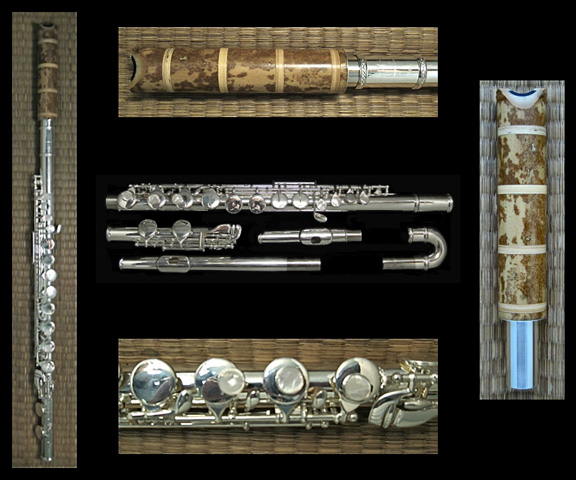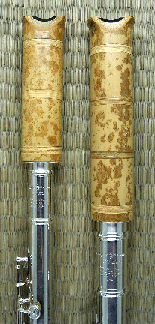www.shakulute.com
Tai Hei Shakuhachi |
What People Say About the Shakulute FAQs (Frequently Asked Questions) Magazine Articles
|
|||
. . . where East Meets West The Shakulute headjoint for the silver flute is a completely new concept in woodwinds originally developed by Tai Hei Shakuhachi in 2001. It replaces the side-blown headjoint of the Western transverse flute with that of an end-blown shakuhachi headjoint to create an innovative new sound and style of music. This hybrid instrument allows the player to employ blowing styles and techniques distinctive to the traditional Japanese shakuhachi while using fingerings common to the western classical Boehm flute. The resulting sound is a unique blend of East and West that can be achieved on no other instrument. It is perfect for the western flautist interested in producing music with a Japanese touch as well as the traditional shakuhachi player who wants to experiment with western scales and intonation. |
||||
| Models of Shakulute | |||||||||
The Shakuhachi Headjoint for the Silver Flute is available in several styles crafted from traditional susudaké, madaké bamboo and torachiku (tiger bamboo) priced to accommodate your budget. Shakulute headjonts are designed to fit any standard-size Boehm flute with C or B footjoint and the alto flute. Each headjoint ordered is carefully fitted to the socket of your silver flute body at no additional charge. |
|||||||||
| Photo |  |
 |
 |
 |
 |
 |
 |
 |
 |
| Click on Headjoint above to view Photo Gallery of each model | |||||||||
Model |
Rare |
Select Madaké Bamboo |
Standard Madaké Bamboo |
Chinese Madaké Bamboo |
Torachiku (Tiger Bamboo) Inlaid Binding |
Torachiku (Tiger Bamboo) Standard Binding |
Cast Resin |
Alto
Shakulute Select Madaké Bamboo |
Alto
Shakulute Standard Madaké Bamboo or Torachiku (Tiger Bamboo) |
| Number | TH-H-S | TH-H-M1 | TH-H-M2 | TH-H-C | TH-H-T1 | TH-H-T2 | TH-H-R | TH-H-A1 | TH-H-A2 |
| Bamboo | Made from rare 150-200 year old susudaké bamboo originally used as roof rafters in traditional Japanese farm houses. Unique dark coloration. | Made from the highest grade of Japanese madaké bamboo with unique coloration and patterns.* | Made from the species of bamboo traditionally in Japan used for shakuhachi. Uniform gold color. | Made from madaké bamboo harvested in Sechuan, China. Distinctive reddish-brown color. | Made from torachiku (Tiger Bamboo) harvested in Shikoku Island, Japan. * | Made from torachiku (Tiger Bamboo) harvested in Shikoku Island, Japan. * | Made from cast resin simulated bamboo. | Made from the highest grade of Japanese madaké bamboo with unique coloration and patterns.* | Made from the species of bamboo traditionally in Japan used for shakuhachi. Uniform gold color. |
Mouthpiece |
Kinko- or Tozan-ryu utaguchi bordered with 14K gold. |
Kinko- or Tozan-ryu utaguchi bordered with 14K gold. |
Kinko- or Tozan-ryu utaguchi bordered with 14K gold. | Kinko- or Tozan-ryu utaguchi bordered with 14K gold.
|
Kinko-ryu utaguchi bordered with sterling silver. |
Kinko-ryu utaguchi bordered with sterling silver. |
Kinko-ryu utaguchi (painted). |
Kinko- or Tozan-ryu utaguchi bordered with 14K gold. |
Kinko- or Tozan-ryu utaguchi bordered with 14K gold. |
| Protective Binding |
Traditional inlaid rattan bindings. | Traditional inlaid rattan bindings. | Traditional inlaid rattan bindings. | Traditional inlaid rattan bindings. | Inlaid lacquered bindings. Simulated urushi (dark red) color. | Standard black bindings. | No bindings |
Traditional inlaid rattan bindings. | Traditional inlaid rattan bindings. |
| Price List | |||||||||
Learn more about options for Binding
|
| All headjoint models listed above are fabricated with seamless tenons made of solid silver rather than brass, copper, or plated material. |
|
Fits Standard C or B,
Alto, & Wood Flutes |
|
 |
|
 Shakulute with C flute. |
 Shakulute with Alto flute. |
 The Shakulute can
be fitted to wood as well as silver flutes. |
|
Shakulute Accessories |
|
 |
|
 |
 |
Included at no additional charge with the following models Shakulute made from Standard Madaké, Chinese Madaké, or Torachiku Bamboo |
|

Susudaké is 150 to 200 year old bamboo salvaged from old straw-thatched Japanese farm houses. Used as roof rafters and celing supports in these buildings, the bamboo was transformed to an auburn color by absorbing the smoke of the ‘irori’ hearth over many years of use. Traditional Japanese homes of this era typically had a central open charcoal pit where a bamboo pole descended from the ceiling near the middle of the pit. A teapot or cooking pot was hung at the bottom of the bamboo pole over burning charcoal. The smoke from the charcoal rose vertically up the bamboo pole and out through a hole in the ceiling, and over a period of time, caused the natural color of the roof rafters to age and become a darker or mahogany color. Susudaké bamboo is very rare and used widely to make implements for Japanese tea ceremony and other traditional arts. |
|||||
Kinko-ryu Utaguchi |
Tozan-ryu Utaguchi |
||||
|
|
||||
Learn more about Rare Susudaké Bamboo
|
|
|
||
Tanifuji Kozan, SHAKULUTE: Live in Concert
A CD of original compositions by Tanifuji Kozan, Grand Master of Tozan-ryu shakuhachi from Hokkaido, Japan. Listen to the |
||
 |
||
|
ALTO
SHAKULUTE DUET |
||










